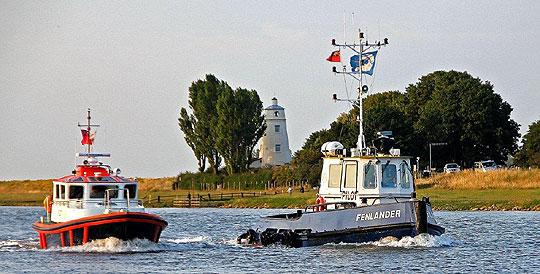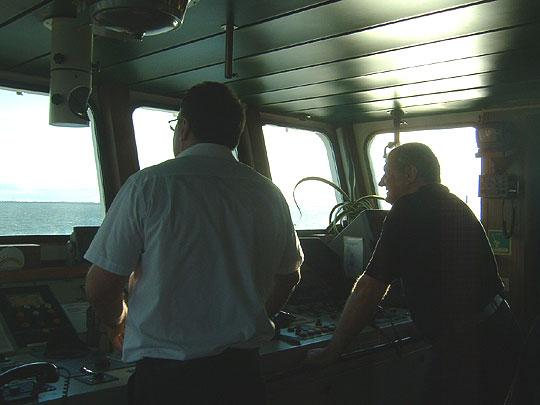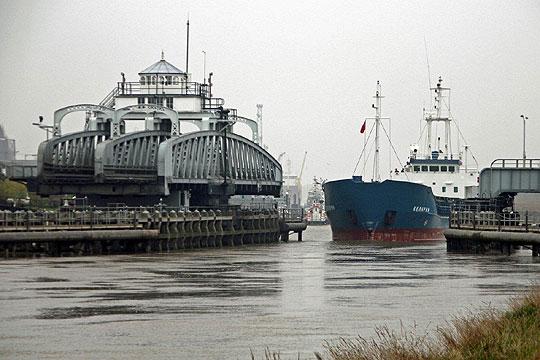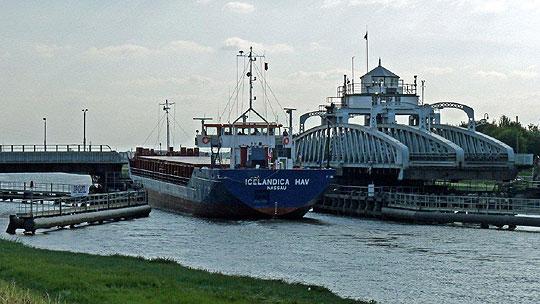MARITIME PILOT
Have you, like me, ever wondered what it is like to bring in one of the big ships that we see moored at Port Sutton Bridge, or which pass through the Swing Bridge on its way to Wisbech? Do you stop your car and watch mesmerised from the bank to see it being effortlessly manoeuvred into the quay? Or are you more concerned about the time you have to wait for the bridge to re-open so that you can continue your journey?
Recently, one warm summer evening, it was arranged with the master of the Russian vessel, the Kovera, that I could accompany the Wisbech pilot, Glenn Lewis, as he brought this 2,300 tonne vessel, 82 metres long, 4.5 metre draft, from its position out in the Wash at the anchorage, into the River Nene, through the Cross Keys swing bridge and to its berth at the port of Wisbech. The Kovera had come from Riga, in Latvia, with a cargo of timber. The ship’s complement consisted of the captain plus eight crew, which included a female cook.
I was given brief instructions on how to don a life jacket and we left the pilot mooring near Port Sutton Bridge in the pilot boat at 6pm, allowing approximately two and a half hours passage to arrive at Wisbech at high water.
On board the pilot boat was the new coxswain, Darryl, the pilot (Glenn Lewis), the harbour master, Clinton Dorrington, and me. We stopped at the port itself to take on board another pilot, Barry Knight, who was to bring in a second vessel to Port Sutton Bridge (PSB). The journey from the pilot mooring to PSB was done slowly so as not to cause too much wash, which would rock the pilot boat as we neared the quayside.
As soon as we had left PSB and picked up speed, the pilot called up the Kovera to say we’d be there in 35 minutes and would be boarding from their port side (on the lee side, out of the wind). There were two ships to be brought in that evening. The other vessel, Thea Marieike, which was to be piloted by Barry, was coming into Sutton Bridge and she was also contacted and a similar instruction was given.
As we passed the tide gauge at the Lighthouse jetty, a reading of 4.4 metres was taken. This is a point of reference which enables the pilot to gauge the depth of water at different points in the Wash.
‘Everything’s critical when you are bringing a ship in,’ said the pilot, ‘the timing, the state of the tide, weather conditions, the height of the water, the depth of the water beneath the ship, everything.’
A pilot has several navigational aids to assist him: radar, GPS (satellite), gyro compass and a rate-of-turn indicator. Because it was a fine evening and visibility and conditions were good, the pilot was able to use eyesight to navigate. However, when there is poor visibility, bad weather conditions or at night, the pilot uses the navigational aids in addition to his eye.
As we came alongside the Kovera, there was had very little time for the pilot and I to board. Once the pilot boat member was satisfied that it was safe, he called ‘Go!’ and we had to go. Stepping from one moving vessel to another is momentarily a bit scary, but you don’t have time to think about that for very long. You just go! On board the Kovera, it felt firmer, steadier and quieter, compared with the engine noise of the pilot boat and the rocking motion as it pulled alongside.
Once aboard, the pilot boat headed off to the other vessel and I followed Glenn up to the top deck and into the Bridge where I was introduced to the ship’s Master before he was politely asked if he would allow the pilot to take over. There is a formal etiquette to be followed: the captain is in charge of his ship at all times and can dismiss the pilot, if he wishes. It has never happened to Glenn and watching him bring the ship safely to anchorage at Wisbech, I can understand why.

Photo by Jim Ramsey

As soon as the pilot took over the control of the ship, he was in charge and acted efficiently and professionally. The first task took place as we passed the Wisbech No 1 buoy. Here the pilot informed the Swing Bridge of the vessel’s position and expected time of arrival at the bridge. The pilot and the ship’s captain then discussed the Passage Plan—a chart that shows the channel that must be followed from the safe anchorage to the Port at Wisbech. The pilot also checked with the Captain that the vessel was in good order and had adequate stability. This is vital, especially when a ship’s cargo is also carried on the deck (as in Kovera’s case) as the ship’s centre of gravity is altered. This effect has to be taken into account in any calculation concerning speed and the course followed.
A pilot needs to know the channel: its twists and turns require some tight, critical manoeuvrings. He also needs to know if there is adequate water to pass through the channel, giving the vessel a minimum of 0.4 under-keel clearance.
The channel is marked by different coloured buoys: red (Port), green (starboard) and cardinal (yellow and black). Their shapes (red-can, green –triangular) also indicate which is which, necessary in case of poor light, or no light on the buoy. The cardinal buoys show the direction position of deeper water. All the buoys are numbered or named after previous pilots or harbour masters, or the sand banks which they indicate.
The arrangement of the symbols on the cardinal buoys and the position of the markings indicate the north, south, east or west direction of deep water. A fifth indicates deep water all round. The red and green buoys mark the extremity of the channel, so the passage between numbers 3 and 9 Green, indicate the shallowest part of the channel and here it is very narrow, making navigation of a long ship tricky. Similarly Red Inner Sand marks a sandbank that is close to where the cross tide might make a vessel go aground.
This happened to one chartered vessel recently when its captain tried to come into the Nene without a pilot and ran aground on the sandbank where he had to wait for some considerable time until there was enough water in the channel to lift him off. It is compulsory for all vessels over 20 metres to have pilot assistance.
It is therefore crucial to keep within the buoys as the waters on either side are very shallow and it is easy to go aground, especially if the sun is in the pilot’s eyes (as it was on this occasion). The pilot cannot afford to take his eyes of his task for more than a couple of seconds! Even though it appears that there is water all around, only a small part of it is navigable.
Seagulls on their way to their roost on the ‘doughnut’—the man-made island that was intended to be a fresh-water store, but is instead ‘home’ to thousands of seabirds— flew across the bow and stern of the Kovera as it changed its course to follow the deep water channel between No3 buoy and Inner Sand (red).
The curves of the channel brought the ship into an area of ‘cross-tides’ and the pilot had to increase speed to get across this to avoid being set off course by the tide. When approaching shallow water, the ship has to slow to reduce the draft to avoid ‘squat’. This occurs when the vessel’s draft is increased due to speed—it creates a kind of ‘dip’ in the water, making less water beneath the vessel.
The returning pilot boat went ahead to take depth of water soundings at the tide gauge at the Lighthouse jetty. If there is not enough water, then the vessel has to wait or slow down until the level rises. We proceeded slowly.
The pilot constantly mentally calculated as he steered, using the depth of the water in the channel ahead of him, the speed of the vessel, and the state of the tide, the time of arrival at various points, making sure he is at the right place at the right time. Much of this information is gathered over the VHF via the pilot boat and from the Port Sutton Bridge Office, which has an electronic tide gauge. All this enabled the pilot to set the right course and speed. The pilot is fully focussed all the time: he barely had time to drink the mug of coffee offered to him by the ship’s steward.
Sometimes vessels that are moored in the deep water channel waiting for the water level to rise have to be contacted to be asked to move away to allow the larger vessel to have priority. The rule is: larger vessels have right of way. As we approached, the fishing vessel Lucky Luke was in the Roads waiting to proceed into Wisbech. The pilot instructed him to go ahead so that we could follow him through the swing bridge while it was open.
Ahead the coastline was becoming more defined. Familiar landmarks could be picked out: the silo in King’s Lynn, the two lighthouses at the mouth of the Nene; wind turbines on Gedney Marsh. Moored near the ‘doughnut’ was Centrica’s cable barge, while on the marsh itself, the two monster machines (Nessie III and Nessie V) used by Centrica for cable laying, stood incongruously in a landscape normally only inhabited by sea birds, samphire pickers and wildfowlers.
The evening sun tinted the sky vermillion. A few walkers on the west bank turned to watch as Kovera left the estuary and glided between the riverbanks. Seabirds took flight from the disappearing mudflats. The banks of the river assumed their shape. The lighthouses were more apparent: gleaming white in the warm sunshine.
At the lighthouses, the vessel reduced its speed to dead slow ahead, giving it a speed of 9 knots (as indicated on the ship’s GPS or speed over the ground). The tide was coming in at 5 knots which gave the vessel a speed of 4 knots through the water. At this point the Pilot contacted the swing bridge again to advise Kovera’s postion and again at the next calling-up position (the double reds). By now, the Kovera was approaching Port Sutton Bridge, and the pilot was keeping to the centre of the channel. Here he again reported to the Swing Bridge and PSB office. The Thea Marrieke, following some distance behind us, began to slow, preparing to swing to come into the Nene stern first.
Keeping to the centre of the deep water channel in the river as a vessel approaches the bridge is vital, even though it brings the ship close to other vessels moored at the quay. It is also crucial to keep in the centre of the channel on the final approach to the bridge to avoid the vessel being drawn into the bank, making the final approach to the bridge difficult. Just before entering the bridge hole, the pilot increased the speed to half ahead to pass through the bridge as quickly as possible to prevent the vessel making contact with the bridge itself. As the bridge is built on a bend, the tide will try to set the vessel into the bridge on the east side. The actual speed of the vessel passing through was increased to approximately 10 knots to avoid this. Once through the bridge the pilot reduced speed to dead slow ahead.
As we were a ‘bit early’—we needed to be at the swing bridge forty minutes before High Water at Sutton Bridge in order to be in Wisbech at the right time (where High Tide is 30 minutes later) to swing the Kovera in sufficient water before mooring at the quayside. Mentally calculating what his speed should be, the pilot slowed the ship again.


By now the bridge was in sight. It was opened and we could see Lucky Jim pass through. Kovera passed Port Sutton Bridge at minimum safe speed possible to maintain safe steerage to prevent the ships moored there from parting (breaking) their mooring ropes.
The open width of the bridge is 21metres; the width of the vessel is just less than 11.5 metres. The pilot has to make sure that as the vessel begins to pass through, it has to be very close (a metre or so) on one side to ensure that the stern on the other side passes clear.
The journey beyond the swing bridge to Wisbech was different. At this point everything was going according to plan for an estimated time of arrival at Wisbech at approximately high water. If the vessel had been running late, an increase of speed would be necessary. If the vessel had been too early, the speed would be reduced by stopping the ship’s engine for as long as the vessel could maintain steerage, and then the engine must be started again. The vessel has to be travelling faster than the tide to give adequate steerage. This is where the skill of the pilot comes in.
Near Foul Anchor, a father and his two young children waved as we passed and gestured to the pilot to sound the siren, but on this occasion he was unable to do this. We waved instead.
By 8.30 pm (two and a half hours after setting out), Wisbech port was in sight. It was dusk, and the port and the faint dark outline and starboard lights of the tug, The Fenlander could be seen ahead. Before berthing, the ship had to be turned in the Wisbech swing basin at Crab Marsh Corner.
This is the tricky part. The pilot asked the Captain to take the controls and take orders from him, the pilot, who by now was on the wing of the bridge and looking over the side, shouting out instructions, all of which were repeated by the Captain, to make sure that both knew the instruction has been understood.
At the same time he was talking to the tug master and the mooring men on the quayside using his hand-held VHF radio. He had to shout to be heard above the noise of the bow thruster, the propellers and the engine. At the same time the Captain was relaying messages to his crew on the bow concerning mooring ropes and the sound of the bow thruster could be heard on the bridge through the talk-back system.
“Three steps to port.”
“Hard at-starboard.”
“Dead slow ahead.”
Darting between the bridge and the ship’s side, the Pilot was constantly monitoring, giving instructions to the Captain and the Tugmaster, James Hodge, on board The Fenlander via the ship’s VHF:
“A slight push, Fenlander, to starboard.”
Back to the captain:
“Dead slow ahead, captain.”
“Two steps.”
“Stop the engines.”
“Midships.”
“Two steps to port.”
“Slight push, Fenlander.”
“Half power.”
“Full power”
I watched from the deck noting the effects of these instructions. At the point where Kovera was straddling the river horizontally, the pilot instructed me to look over the stern. It was now quite dark and people walking on the bank seemed very close to us. The dark murky water was being churned rapidly by the ship’s propeller, keeping the boat in its position. With the help of a rope, the bow thrusters and the Fenlander to push at the bow, Kovera’s bow was nudged into the turning basin. The gap between the ship’s stern and the riverbank was so narrow (5 metres) that you couldn’t help wondering just how this huge heavy ship would complete the turn. But it did. It was a successful manoeuvre.
(It is compulsory for the tug to attend a loaded vessel above a certain length. Its role is to nudge the ship alongside once the ropes have been thrown ashore and the ship is safely moored.)
It took about twenty minutes of steering in reverse to get from the turning basin, round the horseshoe bend and towards the discharging berth where the cranes were waiting to off-load the cargo of timber. By then it was very dark and all the amber lights of Wisbech and the headlights of traffic crossing the Freedom Bridge were dazzlingly visible against the dark sky. Once at the quayside, crew members in the bow and the stern were throwing heaving lines (which are attached to the ropes) ashore and Kovera was safely moored.
Then it was finished: the pilot’s job done, he called to me and we left the Kovera, thanking the Captain and descended to the deck below to transfer to the Fenlander for the trip back to Sutton Bridge. In two days, the pilot returned to Wisbech to take the Kovera back out into the Wash.
The return trip on the tug (Fenlander) allowed the pilot time to relax and reflect. He had been fully focussed on his task for nearly four hours and welcomed this time to banter with his team members. They explained to me that there are many other jobs to be done apart from providing support to the pilots. The tide gauges have to be regularly cleaned to be visible in all weather conditions. The buoys are regularly checked and lights replaced where necessary. Every two years they are removed from the water and rusty chains are replaced. The deep water channel has to be regularly surveyed as the sand banks are always shifting. The Harbour Authority has its own survey boat for this purpose.
As we approached the swing bridge again, the barge Master, James Hodge, contacted the bridge to let them know we were coming. No real need as they could see us, but procedure must be followed at all times. The Fenlander’s engines drowned out the radio tuned to rock music on the shelf behind my seat. The sky was clear except for a thin veil of clouds slightly dimming the moon’s brightness.
“How romantic!” I expressed my thoughts aloud and all three men laughed as if I had made a joke!
The skill and expertise of the pilot, the barge master, the boatman and those on the quayside are vital to bringing a sea-going vessel safely through the narrow and potentially dangerous environment of the Wash and into its river estuaries. Their knowledge of the environment in which they work, their willingness to co-operate and trust each others’ judgment is vital to the work they do.
I wish to offer my thanks to Glenn, James, Darryl, the harbourmaster and the Captain of the Kovera, for the opportunity of being allowed to share for a few hours the complexities of their work and perhaps grasp a little understanding of what they do.
As a final request, (while he was helping me edit this article), the Pilot asked drivers travelling along the river bank at night to remember to dip their headlights when seeing a vessel in the river as this causes dazzle and reduces his ability to see clearly.
P.S.
All ships bound for Port Sutton Bridge with a bow thruster usually come in stern first. This procedure was developed after the Lajik went aground at the turning basin whilst swinging at Sutton Bridge in 2000. As the Lajik blocked the turning basin, it made it impossible for ships to swing, so some method had to be devised to bring ships to the dockside at Sutton Bridge. By bringing them in astern not only saved time by allowing the ship to depart up to two and a half hours earlier than previously, but also made it easier and quicker for the ship to be docked safely and her cargo unloaded. The only ships for Sutton Bridge that now come in bow first are those without bow thrusters and these are discharged of their cargo first and then swung in the turning basin, or if they are bringing in ballast, they are turned first and then loaded with their cargo.
